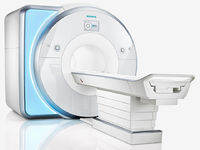Magnetic Resonance Imaging
The CBBM operates a 3T Siemens MAGNETOM Skyra Magnetic Resonance Imaging scanner. The 70 cm open bore and short system design allows for comfortable examinations even of obese subjects. Regarding neuroscientific research the following equipment is provided for structural, functional and metabolic brain imaging:
- 64-channel head/neck coil for high SNR and accelerated imaging
- Simultaneous multi-slice EPI capability for DTI and BOLD imaging
- Recording of physiological parameters: ECG, breathing belt, pulse rate, skin conductivity
- MRI compatible 64-channel EEG system for simultaneous MRI and EEG acquisition
- Multiple MRI compatible response devices: response grips, keyboards, trackball, joystick, mouse, force grip
- Eye tracking
- Video recordings of the face
- Visual, acoustic and electric stimulation
- 1H magnetic resonance spectroscopy imaging
- 31P magnetic resonance spectroscopy (3T dual tuned quadrature head coil 1H/31P)
- Sodium-Imaging (3T dual tuned quadrature head coil 1H/23Na)
BOLD imaging data is subject to a fully automated quality assurance procedure. Standardized phantom measurements are performed multiple times per week, automatically analyzed and published on internal webpages to assure long-term stability and reproducibility.
Internal Wiki-pages (technical information, quality assurance reports, forms):
mrtwiki.cbbm.uni-luebeck.de
Publications
- Göttlich M, Buades-Rotger M, Wiechert J, Beyer F, Krämer UM (2022) Structural covariance of amygdala subregions is associated with trait aggression and endogenous testosterone in healthy individuals. Neuropsychologia 165:108113.
- Alicart H, Heldmann M, Göttlich M, Obst MA, Tittgemeyer M, Münte TF (2021) Modulation of visual processing of food by transcutaneous vagus nerve stimulation (tVNS). Brain Imaging Behav 15:1886-1897.
- Buades-Rotger M, Göttlich M, Weiblen R, Petereit P, Scheidt T, Keevil BG, Krämer UM (2021) Low competitive status elicits aggression in healthy young men: behavioural and neural evidence. Soc Cogn Affect Neurosci 16:1123-1137.
- Erb J, Schmitt LM, Obleser J (2020) Temporal selectivity declines in the aging human auditory cortex. Elife 9.
- Helmchen C, Machner B, Rother M, Spliethoff P, Göttlich M, Sprenger A (2020) Effects of galvanic vestibular stimulation on resting state brain activity in patients with bilateral vestibulopathy. Hum Brain Mapp 41:2527-2547.
- Liebrand M, Karabanov A, Antonenko D, Flöel A, Siebner HR, Classen J, Krämer UM, Tzvi E (2020) Beneficial effects of cerebellar tDCS on motor learning are associated with altered putamen-cerebellar connectivity: A simultaneous tDCS-fMRI study. Neuroimage 223:117363.
- Stolz DS, Müller-Pinzler L, Krach S, Paulus FM (2020) Internal control beliefs shape positive affect and associated neural dynamics during outcome valuation. Nat Commun 11:1230.
- Tzvi E, Koeth F, Karabanov AN, Siebner HR, Krämer UM (2020) Cerebellar - Premotor cortex interactions underlying visuomotor adaptation. Neuroimage 220:117142.
- Alavash M, Tune S, Obleser J (2019) Modular reconfiguration of an auditory control brain network supports adaptive listening behavior. Proc Natl Acad Sci U S A 116:660-669.
- Helmchen C, Rother M, Spliethoff P, Sprenger A (2019) Increased brain responsivity to galvanic vestibular stimulation in bilateral vestibular failure. Neuroimage Clin 24:101942.
Technical coordination
Dr. Martin Göttlich
Tel.: +49 451 3101 7427
E-Mail: martin.goettlich(at)uni-luebeck.de
Büro: CBBM, EG, Raum 5
Siehe Lageplan


